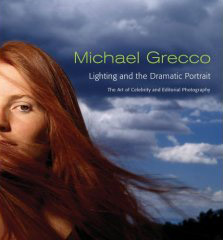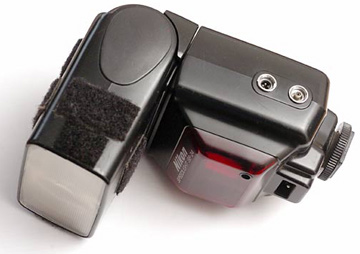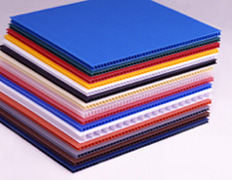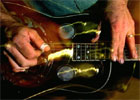
A few days ago, a reader whose opinion I value greatly made an impassioned argument for limiting the content of the Flickr Strobist pool to just professional-quality images.
It was a macro shot that he felt was inappropriate that set him off. But the gist of the discussion was that people were throwing many things up that he thought were of little intrinsic value.
I gave it some thought and came to the conclusion that the sheer diversity of the group's effort was its primary strength. We have seasoned professionals, rank amateurs and everything in between.
But the meat of our bell curve would be the very excited advanced amateur who has just discovered off-camera light and is going nuts with it. And for me, that stuff is great.
Twenty photos of you girlfriend in a week? No prob.
Macro shot of a bug? Yessir.
Skater boyz at dusk in every photo you post? Keep 'em coming.
I absolutely love seeing the ways new-found lighting enthusiasm expresses itself in people's images. I think the kick, for me, is not about
where you happen to be on your personal lighting journey, but how hard you are crashing up against your ceiling as you try to get better.
That said, I believe that all photographers experience a fairly similar series of growth phases as they strive to improve at lighting. Some people may blow through the phases, while others get to a wall - or comfort zone - and camp there for a while.
And once in a great while, someone seems to transcend this process and become the lighting equivalent of Yoda, able to snatch the X-Wing fighter out of the swamp with the sheer power of will. These guys have no predictability to their lighting other than extreme quality.
I love to look at magazine covers and try to guess the shooter. There are a few people who stand out because of their style of light. But very rare is the photographer who is both gifted and versatile to the point where sheer quality and elegance are their only calling cards.
That's always been my goal. Whether I will ever reach it remains to be seen. But the journey is its own reward.
To that end, I worked out a list of what I see as the Seven Levels of Lighting. These are not set in stone. They are simply one person's map of a journey, partially completed, and the road that is visible ahead.
So here they are. I'll spell them out, then tell you where I think I am. Think of your own station, and more important, the growth path you are on.
1. Available Light is BestMany people work under the theory that available light is the only way to photograph. Or maybe they have been burned by bad flash. Or maybe they just do not know.
In many cases a lack of knowledge of quality light (or a fear of flash) leads to a defensive position that backs them into the corner of not creating it. In theory, this has nothing to do with strobe. But since continuous light is visible as you are shooting, the "math anxiety" feeling tends to center on strobe.
For many years we could get away with this as photojournalists because we shot black and white. But color, with various (and mixed) light temperatures has ended that as a crutch. And the web's cheap access to color photography for publication has meant that B&W is a style, not a comfort zone.
There are people who spend entire lives (and careers) here. Which is fine, I guess, if you disregard the potential of what you
could be doing.
2. Competent On-Camera FlashHere is where you'll find the TTL-flashers, the on-camera bouncers, the Gary Fong-ers, the Lumi-Questers, the flash bracket hounds and the vast majority of perfectly happy amateurs.
These are the wine lover's equivalent of folks who are perfectly happy with a bottle of Sutter Home White Zin because they have never really experienced the good stuff.
There are many who make a fine living shooting in this zone - weddings, events, candids, team shots, etc. It is comfy and predictable - which is not necessarily a terrible thing.
Warm milk is not a terrible thing, either.
3. Overdone Off-Camera FlashAt this stage, quality os defined by watt-seconds and f/stops. Pump it all into two umbrellas - at 45-degrees on each side - and a backlight for good measure. Add a hair light while you are at it.
Just nuke it till it glows, dammit. They want f/16 and they want
everything visible.
I have worked with guys like this, and I have never really understood them. For growth, they need more watt-seconds. Maybe f/32.
It's not a very rewarding place to be.
4. ExperimentationIf I had to pick a level where many Strobist readers live, I would choose this one. As often as not, it is because they may lack the f/16-light-everywhere arsenal.
But that is a good thing. Necessity is the mother of invention. Ergo, you are resourceful. And you share notes constantly. As a group, you are like the Borg, learning to light.
It's a fascinating, organic process to watch from my position as gatekeeper of the Small Flash Geeks. I believe it would be all but impossible to be a steady participant in the Flickr Strobist group and spend much time mired down in level three.
Where level three is comfy and predictable, level four is error-prone, and sometimes random in its quality. Which I will take over predictable and boring any day.
5. The Bag of TricksMost competent magazine / agency shooters live here.
He knows what works, and he can make money with it. She experiments, but a has a collection of techniques that she can choose from to craft almost any situation into a beautiful photo.
Grid spot, soft box, flash drag, you name it. They know them all and can cycle them to the point where their pictures do not appear to be cliches of themselves.
To someone in level one, two or three, they appear to be the ultimate destination.
6. Personal and Unique Lighting StyleFrom the bag of tricks, a technique is chosen and carved in stone. The shooter and the technique marry, and live happily ever after.
Often with this style comes huge financial success - and rampant, blatant imitation from others. Think William Coupon's softbox-painted-background icons of the '80's. Or Aaron Jones' Hosemaster images of the same era. (People are still copying him.)
Or Timothy Greenfield-Sanders' elegant, painter's light and subtle, large-format detail.
7. Subject-Driven LightLevel seven is defined by absolute mastery of the craft to the point where it transcends into art on a regular basis.
The command of a wide array of techniques leads to a pure versatility unmatched by other shooters. The key is a variety of styles - singular or combined - from which to choose
The Appropriate Response to a given challenge.
It's the difference between a very good cellist playing a piece, or that same piece being owned by the late Pablo Casals.
It is being so far beyond the mastery of technique that "how-will-I-light-this" is replaced by sheer, instinctive vision. It's craft to the point of genius. It's Dean Collins in his prime.
It's Gregory Heisler, now.
Quoting Heisler, from his website:
"The work is primarily subject-driven. All decisions flow from there. The photographs are all made in response to a unique subject in a particular context at a specific moment in time.
The thoughtful preparedness that defines my working method actually facilitates spontaneity and allows me to embrace surprise.
I always have a game plan but view it merely as a jumping-off point."
That's it, folks. That's the gold standard.
If you think he is BS'ing you, look at his
photos.
You want a compass point for your own lighting journey? Get that mantra tattooed onto your forehead. In reverse, so you can read it in the mirror in the mornings.
If I can get there, I will never ask for anything else. I promise.
But I am not there.
I see myself at the Bag of Tricks level on an average day, sometimes resorting to random experimentation when my bag of tricks fails me.
I want to be at "Subject-Driven" every day. I get a glimpse of it once (maybe twice) a year. Photographically, nothing makes me happier.
I want to work and learn and feel until I can be there consistently.
Where are you?
Where did you come from?
Where are you going?
How are you going to get there?
__________________________
(
The wonderful photo of the Tibetian Monk at the top of this post was taken by Reznorsedge, in Pakistan, in 2002.)







 Flickrite
Flickrite 






